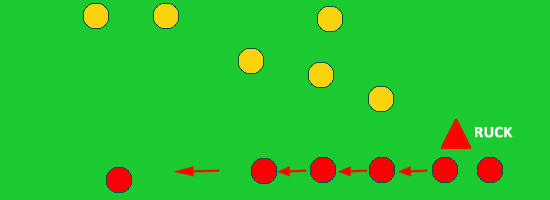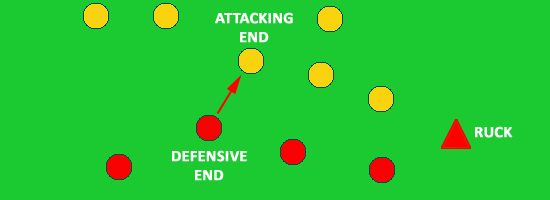With nearly four weeks off from pre-season training for club rugby, I’ve got some spare time on my hands, so what better way to fill that time than to analyse some rugby.
I asked my Twitter followers what they wanted me to take a look at and Luke Baird @bairdey has asked if I can show ways to exploit/attack an ‘Umbrella Defence’.
The System
The aim when using an umbrella defence system is to stop the opposition getting the ball to the extremities of the field by cutting off the ball in mid-field and turning the attack back inside where the majority of defenders are.
When an attacking team has an advantage in numbers out wide there are essentially two ways to try and deal with the issue – containment or attack.
If you choose containment, a ‘jockey’ system can be used where the defenders back off to buy time for inside defenders to work across field to assist. Players move sideways and sometimes also backwards. Territory is conceded but the main aim is to gain time to get more defenders in position to prevent a big line break that could lead to a try. As you’ll see in the video examples this sideways movement often leads to opportunities for the attack to run back in behind the defenders.
If you choose attack, the umbrella system can be used where it’s all about coming up hard on the outside to pressure the opposition and stop the ball being passed out wide but it’s not just an outside man rushing up ahead of the line.
The widest defender, ‘the defensive end’, leads the line up and gets in front of the other players. Whilst I say the widest defender, that excludes the winger, who hangs back to provide wide cover in case the attacking team can get the ball outside the defensive end. The defensive end also angles from outside in to attack the attacker inside them, ‘the attacking end’. When it works, the defending team usually shuts the opposition down well behind the gain line.
The following video shows some examples of the jockey and umbrella systems in use.
[youtube id=”j4gimAfnJhk” width=”600″ height=”350″]
How To Attack The Umbrella System
The umbrella system offers two primary spaces for the attacking team to try and take advantage of – in behind the defensive line and outside the defensive end.
Getting the ball into the space behind the rushing line is obviously achieved through a chip or grubber kick but the depth of the kick is very important – kick it too far and you’ll just be giving the ball back to the opposition. The other thing that’s important when kicking is having chasers – there’s not much point in attacking with a kick if there’s only defenders there to regather the ball. The issue with an attacking kick is that you are largely subject to the bounce of the ball as to whether you can regain possession or not.
Getting the ball into the space outside the defensive end offers a better opportunity to retain possession and can be achieved in a number of ways.
One way that doesn’t work is to stand deeper to try and pass your way around the defensive end. If the defensive end can still get to the attacking end and stop the ball there, the attacking team will have lost even more territory. If the defensive end isn’t going to be able to get to the attacking end they can slow their pace and turn out to target the wider attackers. Even if the ball can be passed to the wider attackers the extra depth of the line gives plenty of time for the inside defenders to get across in cover.
One option a lot of teams use to try and beat the umbrella system is to use the attacking end as a decoy and pass the ball behind them to the wider attackers as the defensive end comes forward – what’s known as ‘playing out the back’. That can be a good tactic but the timing of the pass is critical – pass too early or too deep and the defensive end can slow their pace and turn out to target the wider attackers – pass too late and there’s the risk of an intercept.
Another option which isn’t used as often but is even more effective is a ‘loop’ play with the attacking end receiving the ball early and either an inside attacker or a deeper attacker, such as the fullback, looping around them and receiving a short pass once the defensive end is committed to tackling the attacking end.
The following video includes examples of those options being used.
[youtube id=”Kc113p3UA6A” width=”600″ height=”350″]
Other teams may use different options to try and attack this type of defensive system but hopefully this gives you an idea of how the system works and how most teams try to deal with it.




